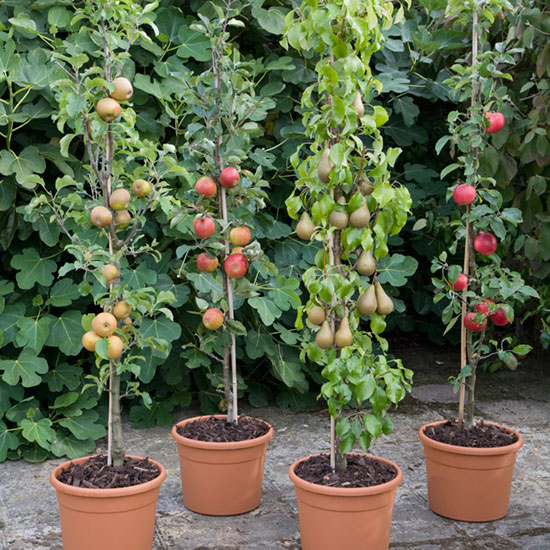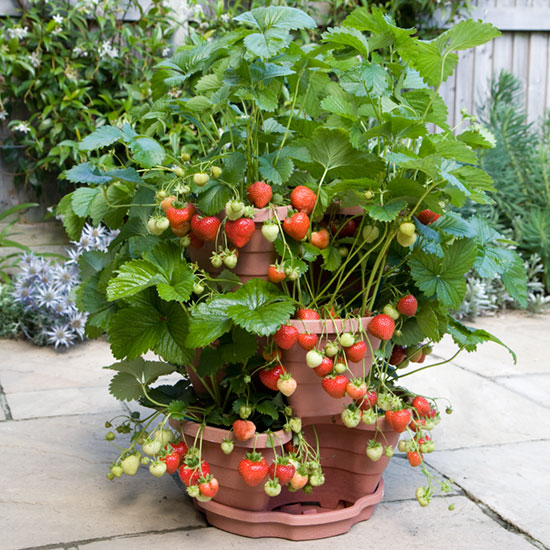It is quite possible to grow most fruit trees and soft fruit plants in containers; however to do this you do need to carefully prepare in the same way that you would prepare the open ground before planting out. Unfortunately many people acquire a tree or plant and then just shove it in a pot or container without any thought and that usually ends up with the poor thing hardly surviving or perhaps dying.
So let’s look at some basic facts. With the exception of blueberries or raspberries always use John Innes No. 3 potting compost. Please do not even think about using garden soil, old or new growbag contents, peat or peat substitutes or even bags of topsoil – you want a well prepared medium which John Innes 3 is. The container you use must be appropriate to what you are planting – neither too big nor too small. I will talk about sizes later on. It is critical that whatever pot or container you use, it has good drainage holes in it. It is essential that water is able to drain away freely after watering or rainfall as if this doesn’t happen the roots will quickly rot, causing the plant to die.
I’m going to start off with trees. You can plant cordon, bush and even espalier and fan trained trees in pots if you want to, but it is important to recognise and understand that you are going to have to water these containers quite regularly and maybe even daily during the summer months. It is equally important to ensure that you don’t buy very dwarfing rootstocks for growing in pots. For example don’t buy apple trees on M9 rootstocks (try M26) or plums on Pixy (try St. Julien A). The reason for this is that the containers are going to do the root restriction bit and we don’t want a double whammy of the rootstock doing this as well. You can plant either bare rooted trees or potted trees as you might for planting in the open ground.
Container size is important. You mustn’t go for the biggest size you can get at the beginning as this will not force roots into growing a good structure for the pot. You need to increase the pot size in stages over the growing years. Initially I suggest that you plant in pots that are 30-40cm (12-15in) in diameter. At the bottom of the pot add a 5cm (2in) layer of stones, crocks or rubble to ensure good drainage and then add your John Innes No. 3. Apply Rootgrow granules (mycorrhizal fungi) to the roots before your backfill. As with planting in the open ground you will still need to stake your trees to prevent them rocking and damaging the roots. You will need to water your pots regularly in dry conditions as it is essential that the roots do not dry out during the growing season. You cannot rely on rainfall for watering as this will invariably be insufficient. You may choose to add a drip watering system to your pots, as this will certainly help when you are away from home and obviate the need for pot sitters!
You will need to feed your potted trees each year and I always recommend using Fruit Tree Feed or blood, fish and bone if you are an organic grower. A good handful in early spring followed by another good handful in early summer is just what the doctor ordered! You will also need to get fresh compost around the roots each year as feeding alone simply cannot provide all of the nutrients to keep the tree growing. For the first three or four years you can achieve this by repotting the tree each winter whilst it is still dormant into a slightly larger pot or container. I suggest that you go no larger than a pot or container 45-50cm (18-20in). Always use new compost and throw the old compost out into your garden. When you have reached the maximum size that I have suggested you should take your tree out of the pot and throw the old compost out. You will then need to prune the roots to a) ensure that they continue to thrive by regrowth and b) to prevent overcrowding. Carefully prune off between a quarter and a third of the bottom of the rootball and then repot using fresh compost. Don’t forget to add the stake back in!
Before I finish with fruit trees I have to deal separately with figs. In order to get figs to fruit we need to pot them up into quite a small pot, certainly one not exceeding 40cm (16in) and keep it in the same pot and not upsize regularly. Every other year take the tree out of the pot and give the roots a prune in the way I noted earlier. As a one off for potting figs I suggest that you use non weedy garden soil that has not been fertilised recently as we want the tree to sit in a poor quality soil similar to that in which it grows in the wild. Feeding wise I prefer not to feed figs unless they start looking weak and pale in which case a light feed in the summer is prescribed. However, do ensure that you water the pots regularly.
So I will now move on to the soft fruit plants which include currants, blackberries and hybrid berries, gooseberries, raspberries, strawberries and blueberries. With the important exception of blueberries and strawberries you should use John Innes No. 3 for a planting medium as for fruit trees. However, for blueberries always use an ericaceous compost and for strawberries I strongly recommend you use a light, free draining compost such as coir (if like me you are an organic grower), or a peat based compost (as used by commercial growers) as this provides ideal conditions for these plants. Strawberries will not be very happy at all in a soil based compost and you will be very disappointed with the results. As with fruit trees (but with the exception of blueberries) apply Rootgrow granules (mycorrhizal fungi) – blueberry bushes will not respond to them.
When growing redcurrants, whitecurrants and gooseberries in pots I always recommend that they are grown as single cordons grown up canes. You might choose to grow two plants per pot or container but I consider that to be enough. With raspberries, I suggest that you plant three fruiting canes in a large pot or container and grow the primocane autumn fruiting raspberries such as Autumn Bliss, Autumn Treasure, Joan J and Polka as they do not grow especially tall and are cut down at the end of the year. You can support these using a tripod of canes. Most blackberries and hybrid cane berries are far too vigorous for growing in pots. The exception to this is the fairly recently introduced primocane blackberry ‘Reuben’. This variety grows to no more than 1.8m tall (6ft) and is easily grown up a cane and the beauty of it is that you cut it down at the end of the year and start again!
As with fruit trees you need to choose your pots carefully. Once again you want to see the roots fill up available space before potting on and you must stake your plants. Possibly the only exception to this is strawberries where you can fit quite a few plants in a small space. Tiered strawberry planters are perfect for this although the same can be achieved by cutting out holes in plastic bins and using them as the planting locations.
The majority of soft fruit plants are relatively long lived and will grow for some time in pots and I tend to only repot these every two years rather than annually as with fruit trees. Again repotting is always done in winter months when the plants are dormant and by moving up sizes as I described for fruit trees. There are, however, two exceptions to this. Raspberries, whilst good for growing in pots, tend to succumb to disease after a relatively short growing period so I suggest that after three growing years they are discarded and then replaced. Strawberries can quickly go into decline and ideally should be replaced after every growing season. However, it is possible to obtain a good crop in the second year but this is best achieved by removing each plant from its growing position, cutting out the spent part of the plant, removing all leaves and replanting in fresh compost. I personally am not an advocate of potting on runners or just leaving the plants in situ and just cutting off all leaves.
Fruit Tree Feed (or blood, fish and bone when growing organically) is again ideal for feeding during the year in early spring and early summer, although for strawberries I recommend using a seaweed feed such as Grow Your Own Seaweed Fertiliser. As with fruit trees watering is critical and just because soft fruit plants are smaller this does not mean they need any less water!
Gerry Edwards
26th February 2015
Gerry is an experienced amateur fruit grower who is Chairman of the RHS Fruit Group, a member of the Royal Horticultural Society’s Fruit, Vegetable and Herb Committee and also their Fruit Trials Panel. Gerry judges fruit nationally for the Royal Horticultural Society and is also a qualified National Vegetable Society judge.



I have just purchased some dwarf fruit trees, I found your article to be very informative and useful. I will be following your advice.
Thanks Gerry
Hi,
No mention or Grapes can these be grown in pots
Grapes can be grown successfully in pots using the Rod and Spur system (which is essentially a cordon system).